Tactical Medicine and Keeping a Cool Head: The Other Side of the Gun-Carrying Lifestyle
Eve Flanigan 07.17.18
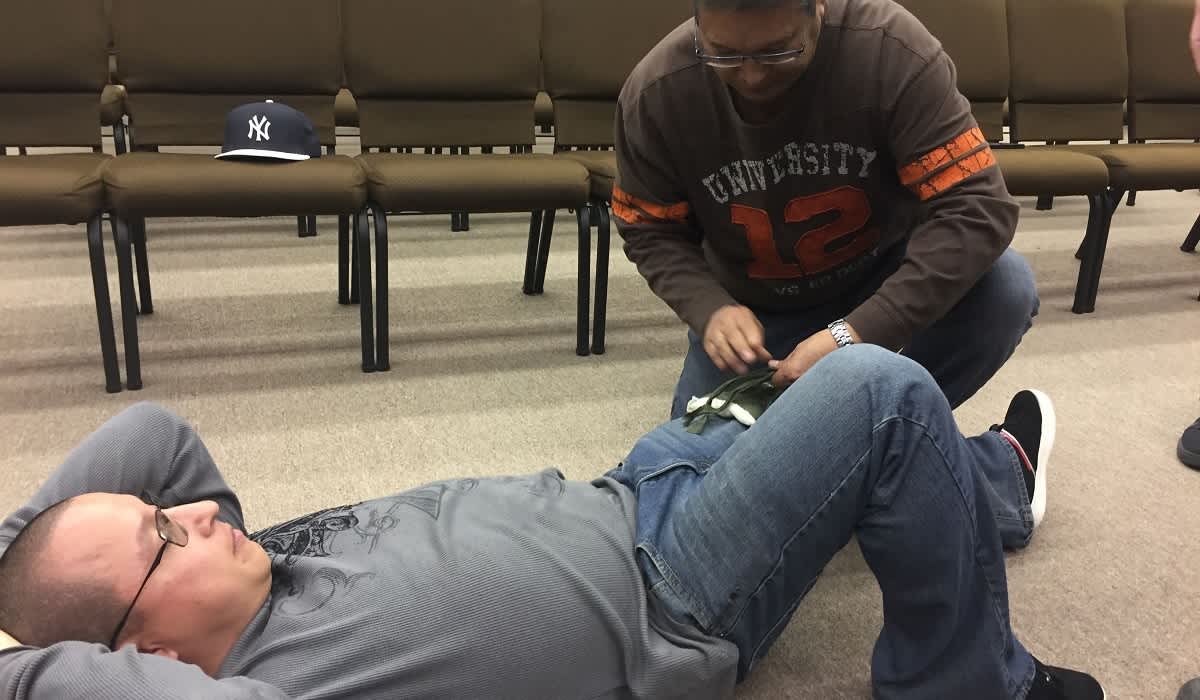
You probably carry a gun to save a life. But what if you or a loved one are stabbed or shot in the process? What if you’re present in a situation where mass casualties happen and you’re unarmed or the attacker isn’t visible? Saving lives isn’t limited to the gun. The tools and technology to stop blood loss, and therefore prevent death in many cases, are readily available and so simple even a pre-teen can perform them.
The Value of Learning to Stop Blood Loss
For many years in the last century, tourniquet use fell from favor due to mostly misunderstood concerns about limb loss. Thanks to the sacrifices of our own military personnel in the age of terror, tourniquets and other forms of blood stoppage are now better understood, and equipment is more user-friendly for both the injured and the rescuing person (who may be one and the same). As a person who carries daily and teaches others to do so as well, I feel it’s a natural progression to learn the simple, affordable, skills associated with stopping profuse arterial bleeding from a limb injury, or even a wound that penetrates the chest wall long enough for the real pros to work their magic.
Most gunshot wounds, and many random injuries such as those related to vehicular and household accidents, don’t need to be fatal or result in major blood loss if someone on the scene can apply very basic interventions. I recently had the opportunity to apply this training to myself and experienced a sharp learning curve about the mental aspects of exercising such skills.
The Gear
In recent years, military field procedures for addressing severe bleeding have been adapted into training for police and first responders. This model is called Tactical Emergency Casualty Care (TECC), and is now routine for many law enforcement agencies. Some trained instructors are sharing their knowledge with civilians. I have been fortunate to receive such training, and as a firearms instructor consider it essential. Although there isn’t yet a certified program for civilians, basic skills can be shared between a trained person, preferably a certified instructor, and anyone willing to learn.
Identifying and stopping a bleeding artery can be accomplished with a little training and is much easier and minimally painful for the injured person with the right tourniquet. Having experimented with several and based on the statements of former active service members and current emergency medical technicians, as well as my own experience and observations of other students of the these skills, two favorites have emerged:
- Combat Application Tourniquet (CAT): This is the preferred and most-issued tourniquet currently in use by US military personnel.
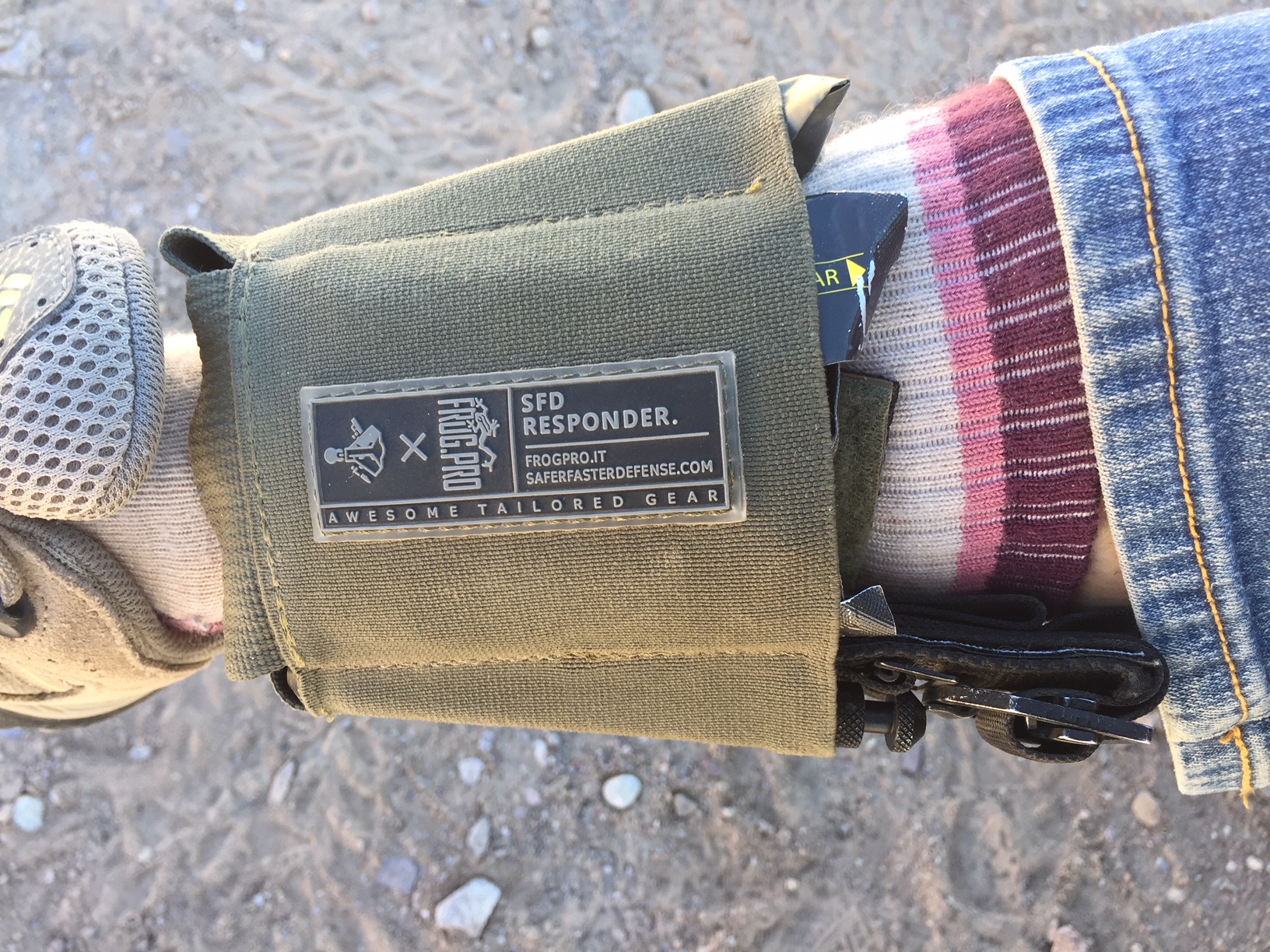
The CAT’s wide webbing and easy-to secure nature make it relatively comfortable and fast to apply and keep tight while evacuating. The downsides of this tourniquet include its unsuitability for use on very small limbs, i.e. children and dogs, as well as the appearance of counterfeit or old products on the market that can risk breakage of the windlass that secures the device.
North American Rescue is a reliable source of current-model (Gen 7 as of this writing) Combat Application Tourniquets. Their website and YouTube channels have good resources for online training.
I carry a CAT in a fanny pack along with other emergency supplies, hung on the headrest of my vehicle. Another lives in the designated “safe closet” of my home. It’s considered by many a superior product, but is slightly too big to ride in a cargo pocket when folded in “ready” configuration.
- Stretch, Wrap, and Tuck Tourniquet (SWAT-T): This is just a simple four-inch wide, several feet long rubber strap that’s capable of working miracles! It comes packaged in a durable but easy-to-open plastic pouch that fits easily into a hip or cargo pocket.
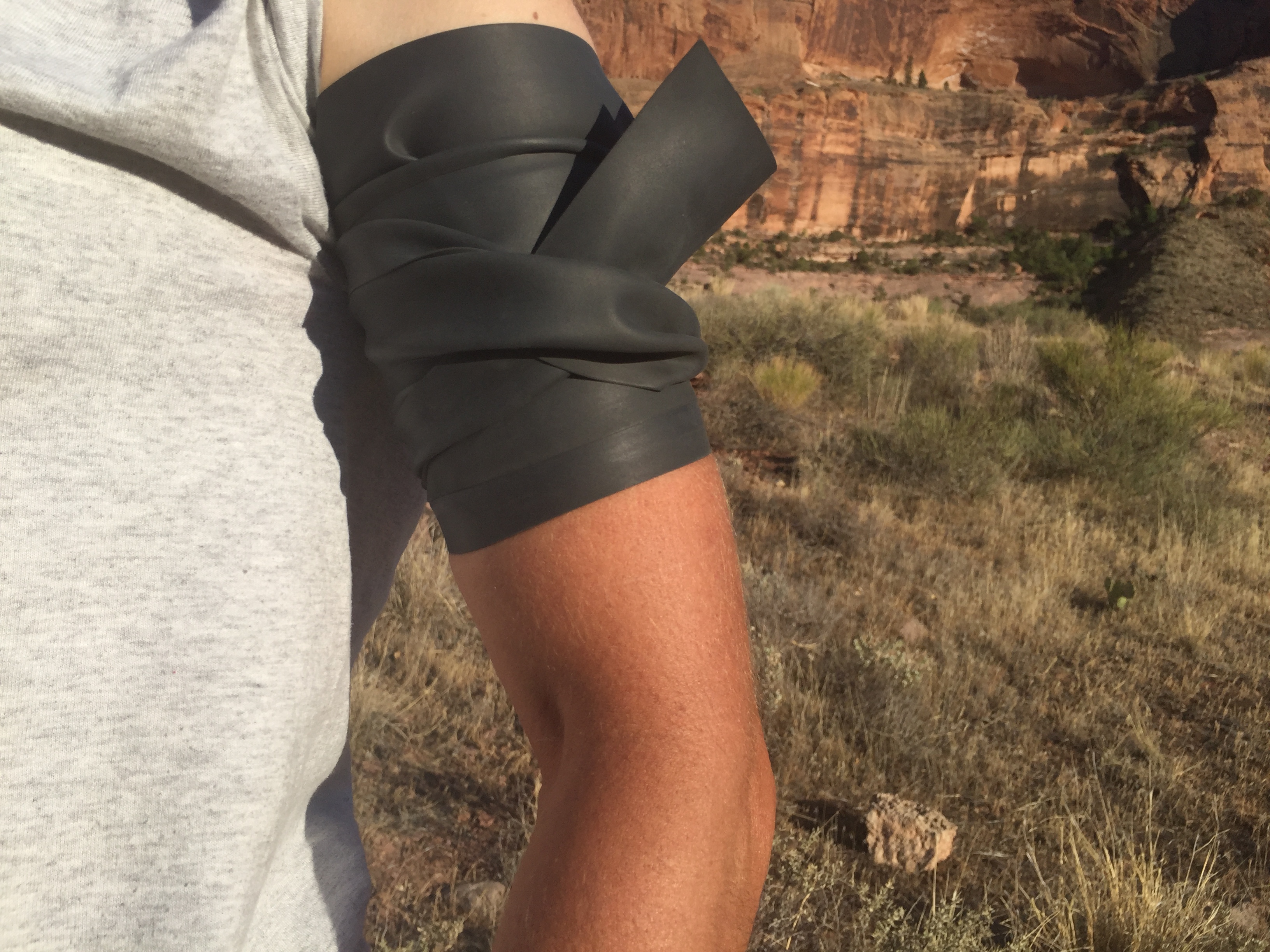
The SWAT-T can double as a compression bandage for severe lacerations or abrasions that need support/protection but don’t represent arterial bleeding. Like the CAT, it’s wide enough to apply comfortably, with the added advantage of being adjustable to fit more body parts and limbs of every size. The downside is that blood, in large quantities, is slippery, and getting the strap tightened down securely can be challenging, especially in an emergency situation.
H&H Medical currently offers the SWAT-T to distributors, who sell it for around $15. Basic training videos can be found on the H&H website.
I have at least one SWAT-T with me on the range and while hiking, sometimes two. The little plastic package not only drops easily into a cargo pocket, it also is an ideal fit in my SFD Responder, an ankle wallet that comfortably packs a more complete, still small, emergency response kit. For a little more room, the Vanquest Fatpack can be attached to other gear and is made for fast, gross-motor access.
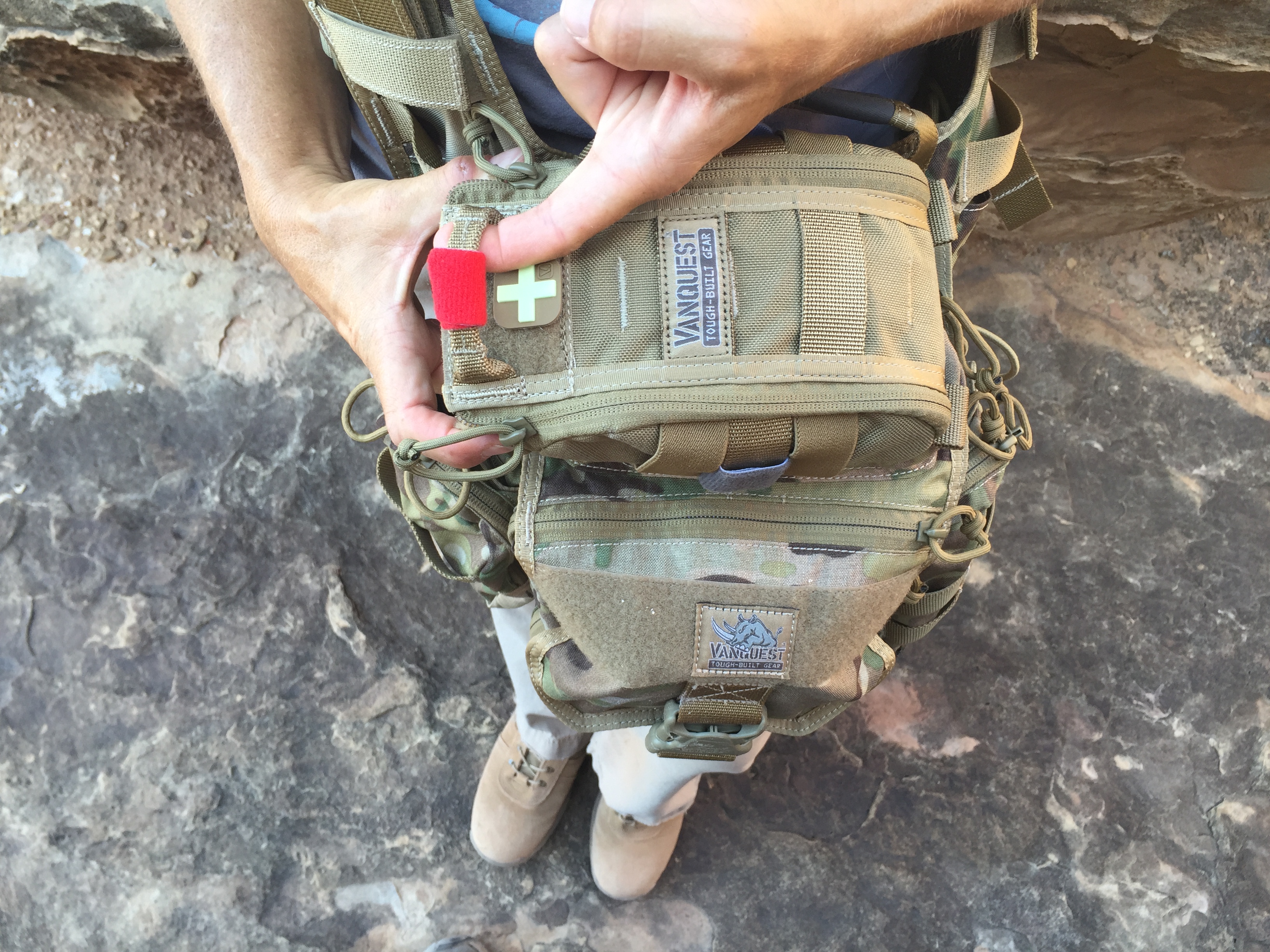
An Impromptu Drill—With Real Blood
Little did I know, the only time so far I’ve used these skills in “real life” would be when a mundane property chore went wrong. While insulating a ceiling, the object I was standing on broke and crumbled. As I fell, a thin metal hook, welded to the wall, caught my arm just above the elbow. No problem, I thought, that was close. There was no pain. And then, moving to arise from the floor, I looked at the wound and was rendered aghast. A loop of flesh dangled from my tricep area, exposing components of myself I’ve never yearned to see. Next, what seemed like a gallon of blood dumped onto my shirt and legs.
I wasted a few seconds screaming before regaining my wits to assess the situation. The steady flow of blood made me think of applying a tourniquet.
Was it an arterial bleed?
As my mind asked questions, training seemed to answer them automatically. No, it’s dumping not spurting blood.
Could it still be life-threatening?
I decided not to chance it. Bracing the arm against my side so the flapping of newly loose flesh didn’t gross me out, I ran to the car and applied the CAT that rides on the headrest.
The drive to town and medical attention tested the limits of good sense, but also confirmed to me that there are a host of benefits to remaining calm and managing one’s thoughts in a medical emergency. Breathing deeply, so the expansion of air seems to fill the gut and not the chest, is a habit from tactical training that I was glad to have on board. A chill threatened to overtake me, as did a sort of urge to shiver. Recognizing the signs that shock was trying to have its way, I concentrated even harder on breathing well and driving well. On the drive, I’d also called 911 for the purpose of alerting the emergency room of my arrival. Communicating my location every minute or so to the dispatcher was embarrassingly comforting, giving my mind something to focus on rather than give in to the pull of panic and fear.
Emergency department personnel confirmed the pulse rate in the hand of the injured arm was zero—the CAT did its job. They also confirmed, that, thankfully, no brachial artery damage had occurred, and that the tourniquet had saved me from excessive blood loss.
Skills Plus Mental Management are Key
Training to stop blood loss is a good thing to have for anyone who carries a gun or does work or play that’s even remotely dangerous—that includes driving! As my experience shows, the management of thoughts and emotions is a powerful and necessary companion to technical skills.

